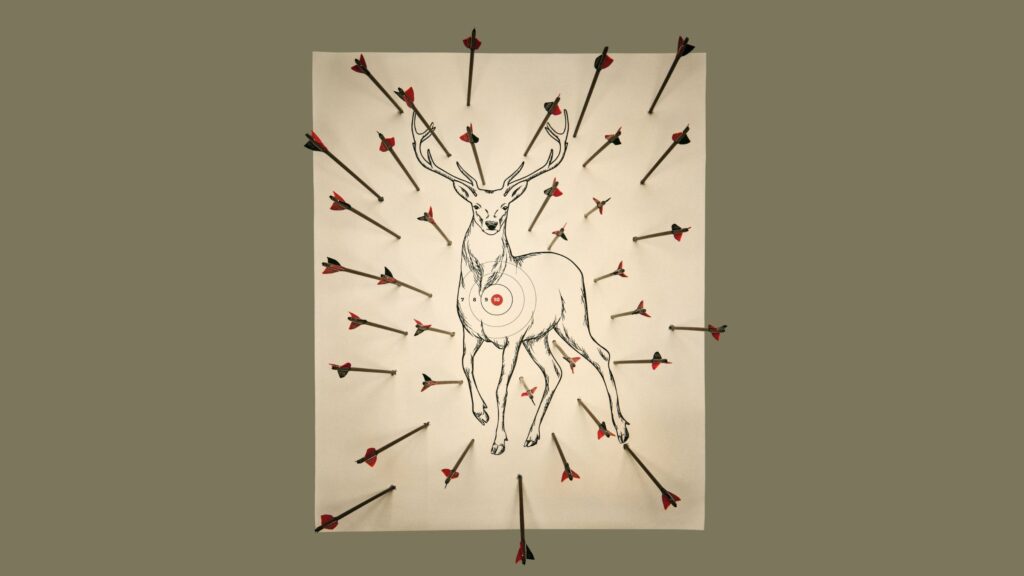Meet Carl Cocchiarella, Colorado’s least-successful elk hunter. After four decades of near misses, he’s learned that killing an animal isn’t the best part of a hunt.
(Photo: Fredrik Broden)
Published October 15, 2025 05:05AM
When I located Carl Cocchiarella on a hillside at 10,500 feet, after hiking for hours toward a blue dot on my phone, he was eating lunch in the shade of a large spruce, blended with the terrain like the savvy hunter he is. His $2,000 compound bow rested in the dirt. He chomped into a flour tortilla slathered in peanut butter while reclined next to his hunting partner, Teig Olson.
I would give you a rough idea of where we were, except Carl insisted I refer to the location only as “the high country of Colorado.” He explained why: “Hunters are territorial, and they have guns.” So did he: a Glock strapped to his hip, in case a large predator tried to move in on his kill. The prospect of him killing something, however, constituted a mighty if, considering this was Carl’s 40th year as an archery hunter and he had never harvested an animal with an arrow.
It was early September 2024, the second day of Colorado’s bow season. Carl, a 65-year-old house painter from Vail, held elk and deer tags good for both sexes but so far had not seen any animals. The sun’s heat felt like it does in July. Carl had dark, greasy smudges on his cheeks to avoid detection by his targets, and was dressed in a camouflage long-sleeve hoodie and beige pants. He would have been nearly impossible to spot if not for his 75-liter azure backpack, which could only be camouflaged in an ocean.
Carl started hunting, with a rifle, in 1983, drawn by the idea of filling his freezer with meat. He harvested a large buck his first day out, downvalley from Vail. Then he got a bow and never went back to bullets. He still owns a very nice rifle and knows it would improve his chances. But harvesting on its own is no longer worth the concessions in style and pride—and hasn’t been for decades.
Teig, a local electrician 24 years younger than Carl, has no problem making such concessions, even if his heart, like Carl’s, belongs to his bow. Resting in the shade, Teig was camouflaged from his ballcap—a brown flat-brim that read “Elk Hunter”—to his boots, all 6 feet and 3 inches of him. He spoke only in whispers.
Sometimes Carl and Teig hunt with other people, but mostly they go with each other. Their relationship skews toward mentor-mentee—Carl the self-deprecating sage, Teig the highly skilled understudy—owing to Carl’s experience in the mountains more than their respective hunting records. Quietly through the years, Carl had built an impressive list of conquests: he skied the Messner Couloir on Denali, riding out three nights in an ice cave at 17,000 feet; climbed the east ridge of Mount Logan, North America’s second tallest point, during a blizzard; made a first descent in Patagonia; summited three peaks in a season in Peru’s Cordillera Blanca; and kayaked the Grand Canyon.
He also survived a full avalanche burial on Vail Pass before transceivers were widely used; a thunderous slab in British Columbia that nearly washed him over a cliff—saved by a sapling that he grabbed at the last second; and a crevasse fall on Mont Blanc that left him dangling above death.
“Carl gets a lot of good days because he’s not afraid of the bad days,” says Scott Toepfer, a retired avalanche forecaster and one of his closest friends, summing up Carl’s approach to adventure.
Teig, meanwhile, grew up in the Vail Valley and started hunting as a grommet, following his dad through the forest with a rubber-band gun. He killed his first elk with a rifle when he was 12. As soon as he tried bow hunting, he says, “I caught the fever.” He found its intimacy—most shots are taken within 40 yards—“addicting. You only get one chance.”
Over 16 seasons as an archery hunter heading into 2024, Teig had harvested four elk, including a 600-pound bull that fed his family for two years. That success rate was about two and a half times the 2023 average, which hovers around ten percent in Colorado and serves as one of the discipline’s chief deterrents. Teig’s father never got into bow hunting. “He’d say, ‘No, I’m not a vegetarian,’” Teig recalls.
I had backcountry skied with Carl for years and often heard stories about his hunts, tinged with hints of hilarity. I also knew he avoided attention; allowing a reporter into his fold went against his ideology. He agreed to let me chronicle his season reluctantly.
More than simply accompanying him through the forest, I was here to see how Carl, a proud outdoorsman, self-made and successful, had lasted four decades in a sport built on results. How did he maintain his passion in the face of so much failure? And what life lessons might be buried within his futility?
Just downhill from their lunch spot, Carl and Teig made a plan in hushed tones that would take them back to camp by sunset. “I’m gonna go slow,” Carl said. “I might sit down.” “That’s fine, Carl,” Teig replied. Carl smiled. They fist bumped and tiptoed in opposite directions.
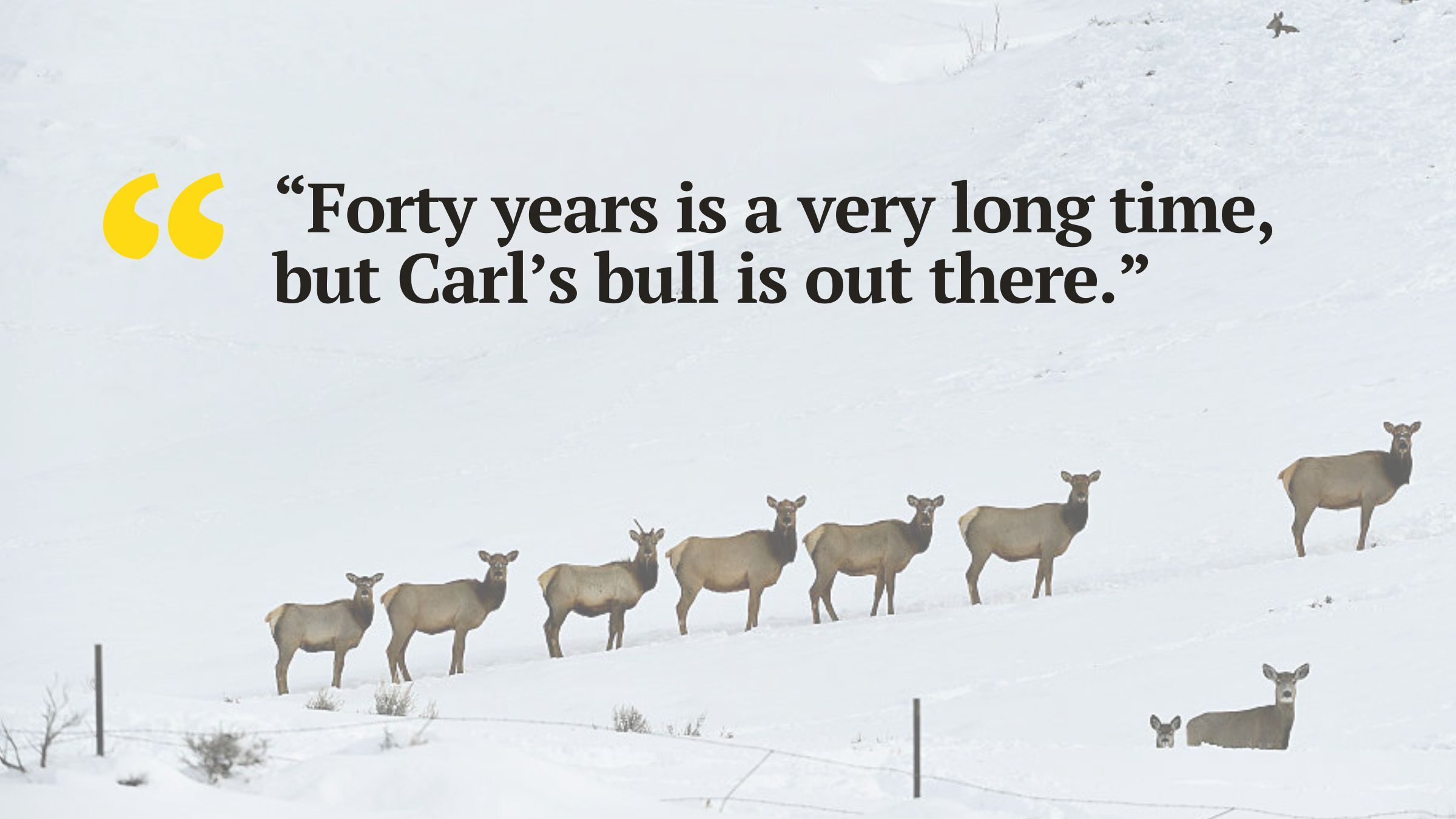
Part of Carl’s mystique as a hunter comes from the lines he draws, indicating what a harvest is actually worth to him. Yesterday, for instance, was his first time ever hunting with a map. He prefers to scout land in person or with binoculars. “Isn’t it better to feel something?” he said. “Float the river. Taste the chocolate. Plus, I’m dyslexic.”
He prowled the forest like a cat, careful to avoid snapping twigs. He stabbed at a pile of elk dung with a ski pole, picked it up, broke it in half, and smelled it. “Not quite warm, but within the hour,” he said, scanning the forest. “They’re in here.”
If you didn’t know Carl had survived treacherous adventures around the world, he could be easy to underestimate. “I’m just not athletic. I can barely get my shoes on. I can’t jump more than four inches in the air, I swear to you,” he said. He used to stand five foot seven but had shrunk to five foot five, still mostly muscle, with a lower half like a bobsled racer. “I think if I had more height, I’d get more animals.”
We sat on the edge of a clearing and strained to examine each gap in the trees, each glint, hoping something might stroll by. Carl plucked his “lucky rock” from his pocket and rubbed it. Nothing appeared. After a half hour, he concluded: “The animals, I think, know I’m a good shot and they’d better not get in the way.”
By the time we hiked into camp, Carl had been out for 12 hours—his second full day without seeing an elk or a deer. If he was discouraged, however, he didn’t show it. One of his trademarks is that every moment he’s out there, he believes his streak is about to end.
On the third morning, Carl woke up at 5 A.M. and decided not to hunt. Instead, we talked at camp before packing up and beginning the 30-minute hike out, so he could get to work wiping down deck boards on his hands and knees.
“This is very elky; this whole area is,” Carl said as we descended through an aspen meadow. He was 20 feet in front of me when suddenly he dropped his ski pole and began moving in a crouch. I saw it too: a sturdy doe, maybe 40 yards from Carl, all alone. He closed the gap. She kept eating grass, head down. He notched an arrow. The doe, standing broadside, stepped behind a spruce branch. Carl felt about 60 percent confident in his shot—not good enough. He inched toward a better position. Just then the doe saw him. She bolted before he could draw.
Later, at the truck, still buzzing from the encounter, he said: “That’s to get you back. It’s like golf—one good shot. I didn’t even have to take a shot. I finally saw an animal. I actually got to hunt.” He shook his head. “Oh, I had her. If just that branch wasn’t there.”
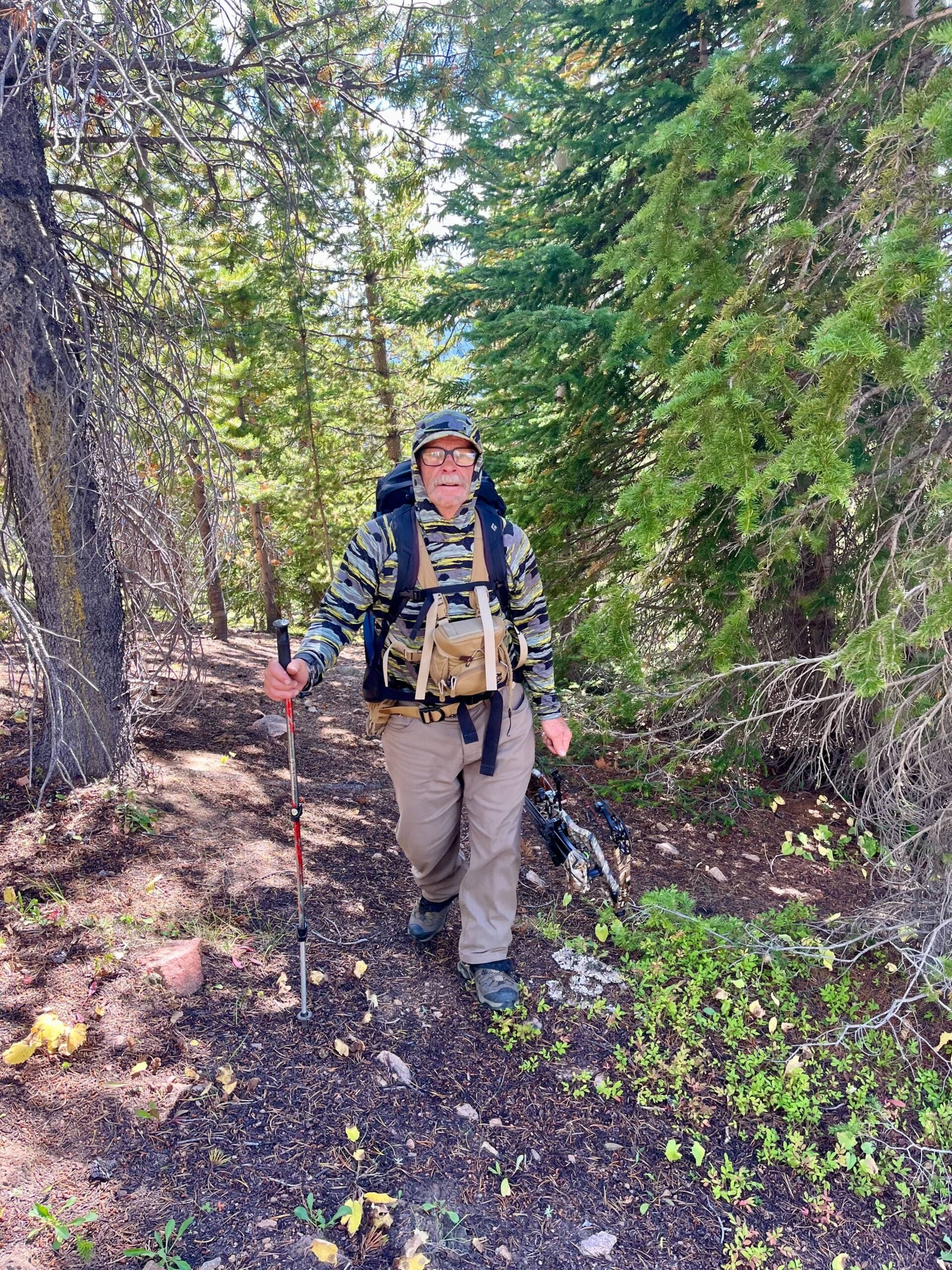
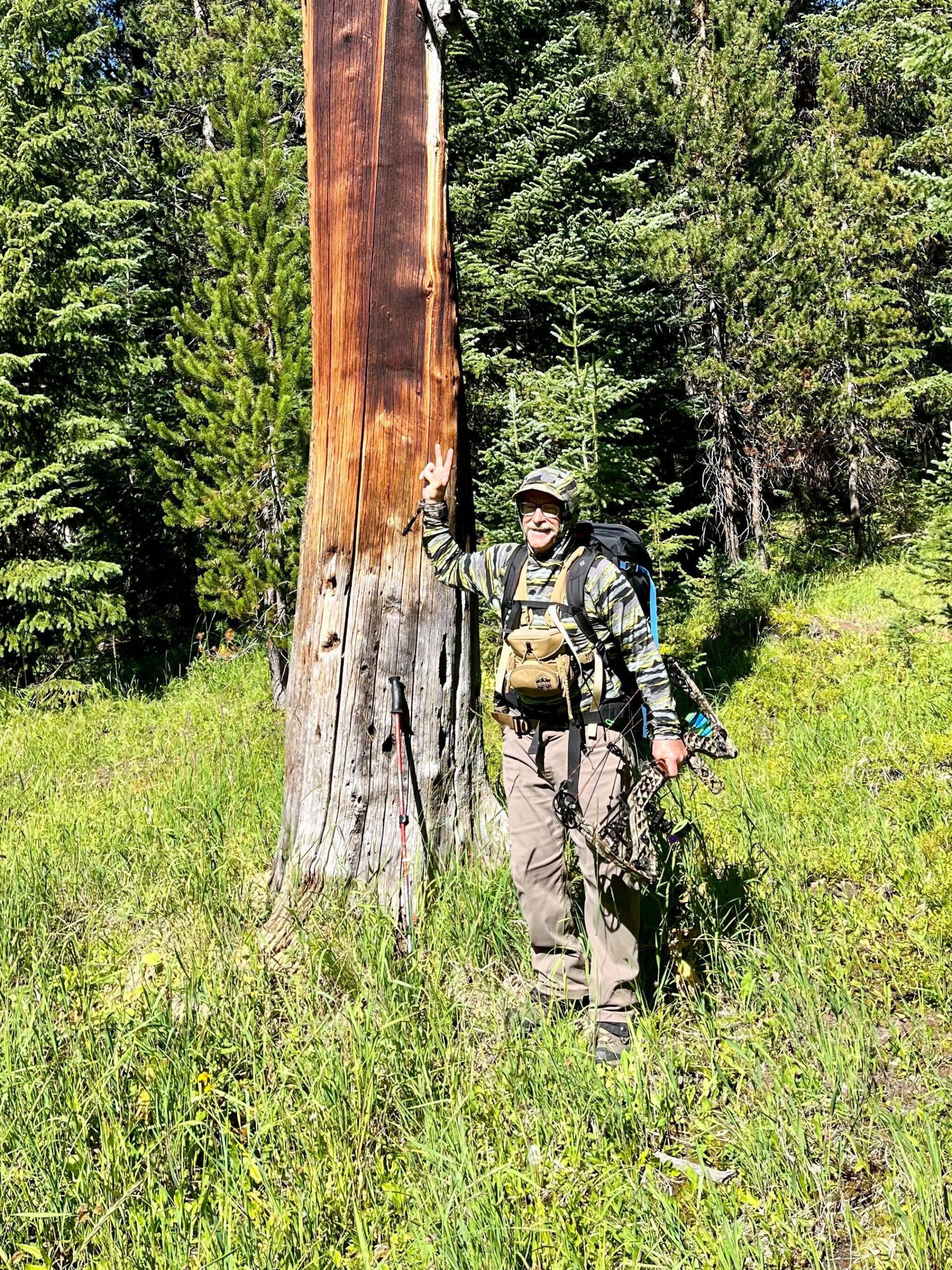
Carl’s zeal for the outdoors began at an early age. Born in Manhattan to an Italian father and Swiss mother, the family moved to Gloucester, Massachusetts, when Carl was 8. His parents took him and his two siblings camping or skiing every weekend. He maximized what he had, fishing from shore while his friends fished from motorboats. After earning an accounting degree, he drove his van to Colorado in October 1982. It broke down in Vail, so that’s where he stayed.
Carl didn’t just kill one buck the day he debuted as a hunter. He killed two. He finished off the first after four men had wounded it and began chasing it toward him, firing at will—his shot an act of self-preservation. An hour later, in the midst of a blizzard, Carl took down a bigger buck at 150 yards, across a ravine. Though he loved the quick results, he didn’t appreciate having bullets whiz over his head. He had grown up shooting a wooden recurve bow in his backyard, and the simplicity appealed. He was stubborn, hardworking, and tough, traits that aligned well with hunting’s noblest form—even if it remained a hobby.
Carl earned a reputation in Vail for his daring ski descents and vivacious personality. He met a fellow adventurer named Jimmy Klein, who became his best friend. They bought land together and built a cabin. In December 1994, however, Jimmy was climbing a frozen waterfall in Glenwood Canyon when the ice collapsed, killing him. Jimmy’s son, Tucker, was three weeks old. Carl and Jimmy’s widow, Kate, who grew up in Vail, subsequently fell in love and married. Carl adopted Tucker. He and Kate later welcomed a daughter, Rachel.
Kate, who used to joke that “none of the Cs in ‘Carl Cocchiarella’ stands for commitment,” remembers the talk they had before Carl agreed to settle down. “He was like, I can do this and be your partner, but I’m still a mountain man, and I’m going to stay a mountain man,” Kate says. “And I said, yeah, that’s what I love about you and that’s what you do. I’m not going to stop you from doing what you do.”
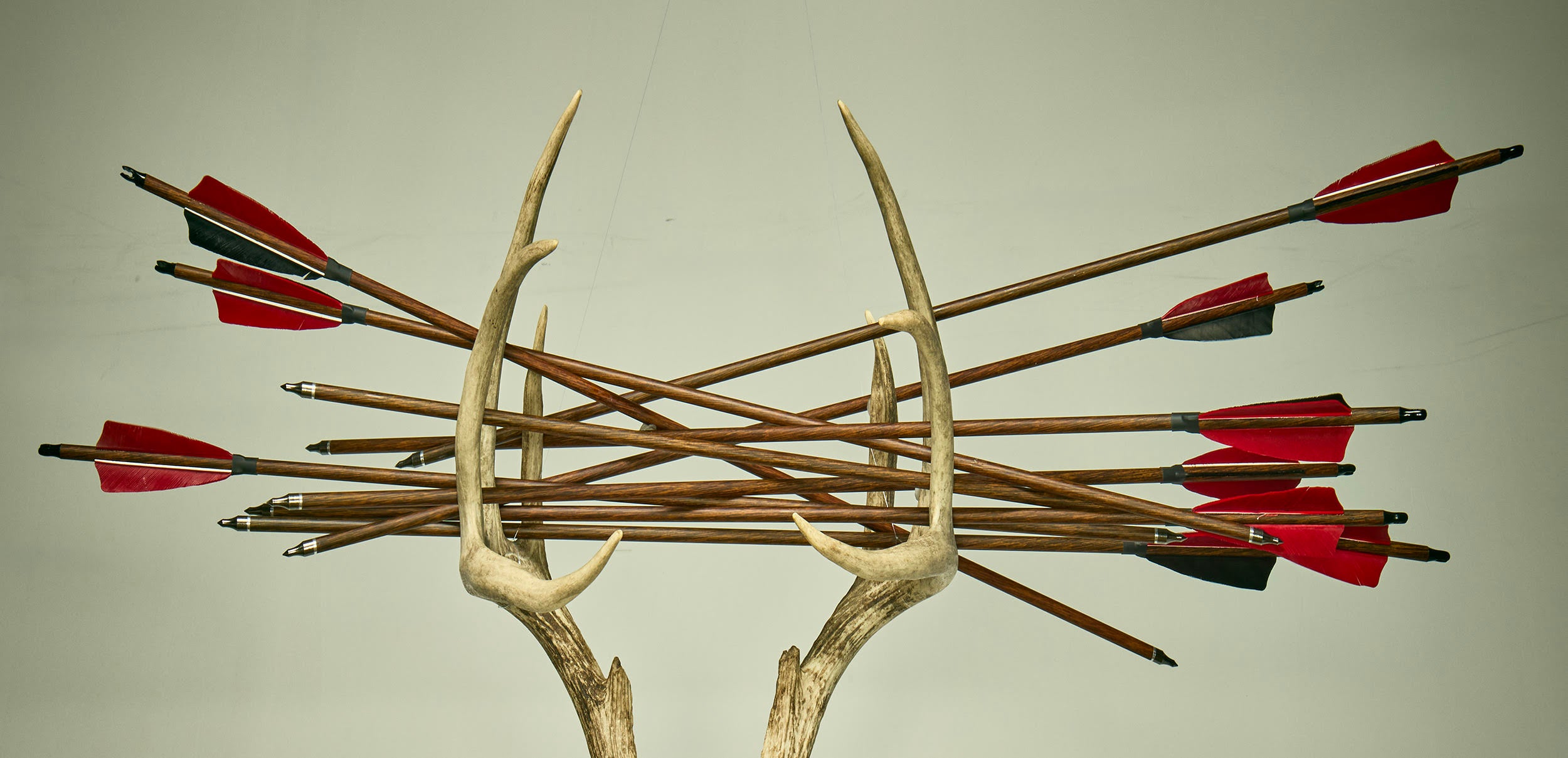
It is hard to find a place with better hunting opportunities than Colorado—even if the harvest statistics don’t always show it. The state features more than 23 million acres of public land and is home to the largest elk herd in the country—an estimated 303,390 animals, according to Colorado Parks and Wildlife. That’s in addition to 375,710 deer roaming the state. Carl has plenty of company in his quest: 186,000 hunters bought an elk tag in Colorado in 2023, including 50,000 bow hunters (a tag for residents costs $66.12, while non-residents pay $803.39). Much like the house always wins in the end, you could argue so too does the herd: it took an average of 71 archery hunting days for each harvested elk in 2023.
The odds are even longer where Carl hunts, a zone known to hold thinner herds and rougher terrain. But he prefers to go on his terms, in a familiar place with fewer people, rather than chase a more likely kill. He could talk for hours about his near-misses. Like the time when he called in a bull from hundreds of yards away, listening to it crash through the forest, ever nearer, until it stood close enough to hear him whisper. He and the beast locked eyes. “I had my arrow notched, and I started pulling up just a little bit,” Carl recalled. “I probably should’ve stayed still. There’s always something you think you didn’t do right. He just turned around and ran. Then it was quiet for 10 days.”
In 39 years, Carl had taken only one shot (he also skipped two seasons during that time). It happened three years ago, while stalking a four-point bull at 40 yards. He’d spent years honing his aim on a target in his backyard, but as soon as he fired, he watched the arrow graze a leaf, soar over the bull, and smack dirt. The elk let out an angry bugle then took off uphill, spitting as it ran.
Three weeks after I’d watched Carl opt not to draw on the doe, he and Teig were back in their favorite zone, hunting a few hundred yards apart, when all hell broke loose. Teig came upon piles of green scat, a telltale sign that an animal was close by. He spotted a tangled web of branches, then saw them move and realized he was staring at antlers. The six-point bull turned broadside, and Teig pulled his arrow back. Just as he was about to shoot, however, 10 cows sprinted past the bull, spooking it and likely saving its life.
Carl had barely read Teig’s text about the encounter when his own opportunity appeared. It was another doe, 30 yards away, gawking at him. He was surprised she didn’t move as he notched an arrow. He pulled it back; still no movement. He aimed through a narrow hallway of lodgepole pine, slightly downhill—a perfect shooting corridor. I’m gonna get my first first animal! he thought. The doe’s eyes blinked on either side of a spindly trunk. Carl released his arrow and watched it whiz like a missile. He heard it hit flesh, or bone—he wasn’t sure which—and for a moment, the outcome didn’t matter. He’d taken a shot and hit an animal. Then the doe took off, and the gravity of his imprecision sank in. He started tracking her path through the forest, following drops of blood, feeling his anxiety rising. To wound an animal is not just unfortunate, it is the worst-case scenario. He and Teig spent two hours on the doe’s trail, until eventually the droplets dried up. Carl later estimated he’d missed her heart by six inches.
In the ensuing days, I would get the feeling the close call haunted Carl more than he let on, fateful as it was in his bowhunting career: a source of exhilaration and distress, internalized with time. But that night, he espoused a more lighthearted take.
“It would’ve been great if I took the shot and she just fell down the hill,” he said at camp. “I could’ve cut her throat and drunk the blood and put it on my face and cut the heart out and eaten it with you. Killah! Killah! But I guess this is all part of the process. You can’t bat a thousand.”
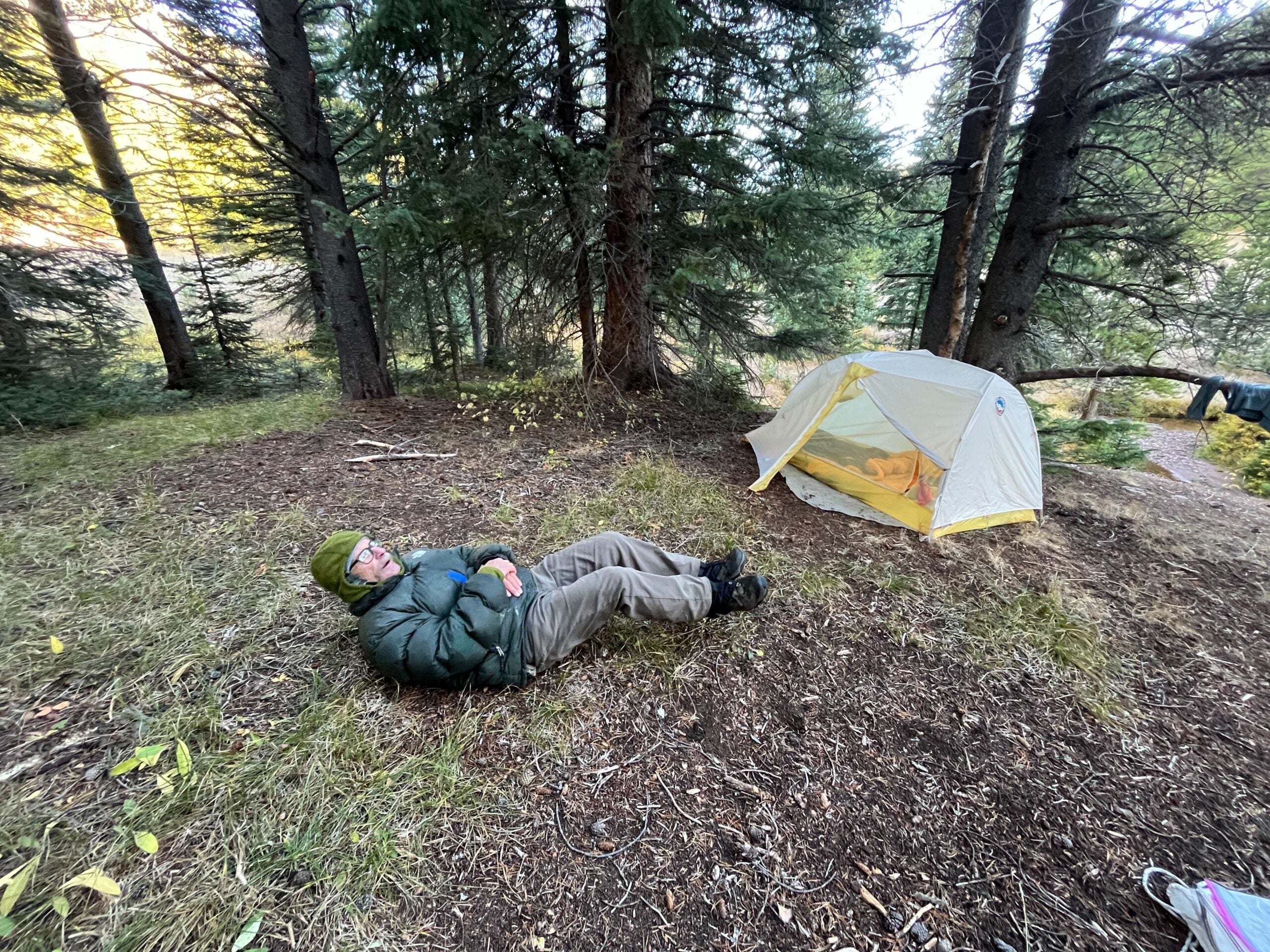
By the next morning, Carl’s optimism seemed to have returned. We’d moved camp to a new drainage, and he and Teig headed out at dawn under a wispy sky that looked like an Impressionist painting. Carl yielded the more favorable course to his partner, through a wetland. “I care about Teig’s hunting more than mine,” he said matter of factly. We started climbing a densely treed hillside that felt almost sheer, following a network of game trails that he seemed to know as well as the animals. “The best thing about hunting is I can keep up with people,” he observed. “Because the slower you are, the better you are. So I’m perfect. And I still sweat.” He took a sip from his water bottle, which he’d spiked with a probiotic powder. “Wow, that is fucking good.” Why do you take probiotics? I asked. “Chuck Norris,” he replied.
Carl aimed to complete 500 exercises a day, be they pushups, situps, arm windmills, or dance moves. Whenever we had a minute—which happened a lot during a dawn-to-dusk hunt—he dropped to the ground and banged out a set of 20, taking care not to disturb his Glock.
Suddenly the wind shifted, and we smelled elk. Carl sent out two quick cow calls. “We’re catching up to ’em,” he said.
We never caught them, however.
That evening, after scarfing a dehydrated meal that he’d purchased at Walmart, Carl donned camo slippers and cracked an IPA. The next morning we would hike out empty handed again, the season’s end drawing nearer. His mind wandered back to the wounded doe, and the error he’d made when it was time to kill. “That’s what pulled my shot, I think. I was looking at her eyes,” he said.
I asked why he still believed he would get an animal, after so many empty seasons. For the first time, I sensed him recoil, as if his ethos had been challenged.
“I don’t think it has anything to do with believing,” he snapped. “I mean, that’s beyond what I’m trying to do out here. I love hunting. I’ve gotten what I really needed.” He leaned back in his chair, legs extended in a cross, smiling like a king. “I’m having the greatest time ever.”
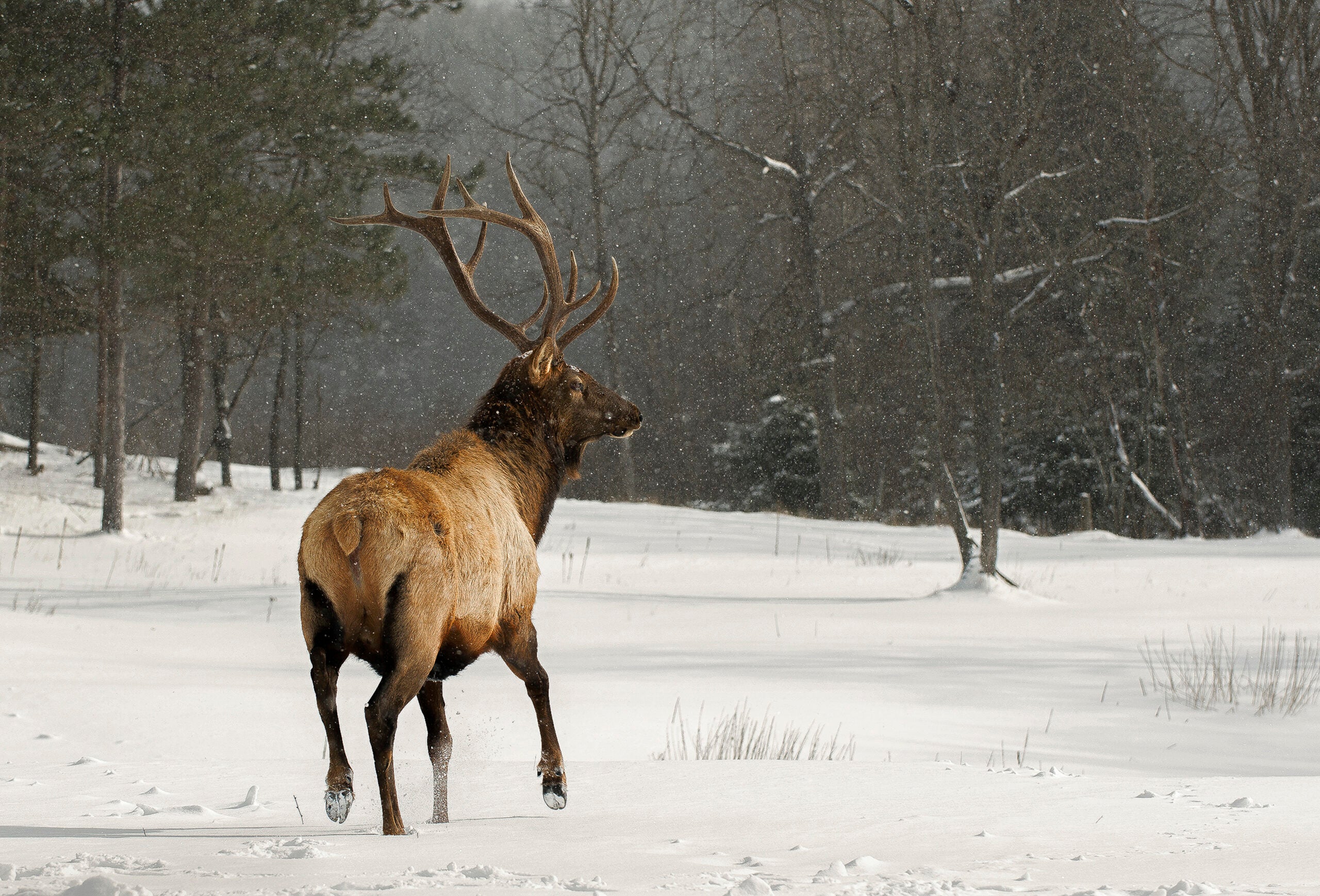
The first bugle ripped through our campsite at 7:40 P.M.
It was Sunday, September 29, the night before archery closing day, and I’d joined Carl and Teig for their final hunt. They knew animals were in the area: Carl saw a huge bull at dusk, wandering above camp, and Teig observed fresh signs all day—hoof prints, scat, and beds in the grass. A second bugle followed the first, kicking off a sequence that would last for 10 hours. After a month of chasing ghosts, suddenly, it seemed, we had landed in the “magic circle,” surrounded by targets. The wind drifted down from the animals toward camp, concealing our presence.
We sat in the dark enjoying the concert, unsure whether the vocalists were herd bulls, calling to their harem, or satellite bulls, basically smaller hangers-on that wait for the sultan to drop his guard then, as Teig explained, “swoop in for a quick fuck.” Teig sprayed “cow piss”—mist taken from the urine of an elk in heat—into the air for good measure.
Carl, who spent much of the day photographing bark and woodpeckers, was savoring his 12th night camping this season, a personal best. Teig had gotten 15. As we faded to sleep in our tents, I couldn’t help but think destiny was in play: Carl’s streak was finally, mercifully about to end.
The last bugle rang out at 5:30 A.M. Carl and Teig were huddled in the dark, strategizing. “We’re gonna pincer him,” Teig whispered, explaining that he would circle around the bull and push the herd, however many it included, down toward Carl. Teig took off. Carl strained to catch a glimpse of brown fur through his binoculars. He texted Teig: “Up 100 yards on hill. You’re going to them.” Then he saw more. “Holy shit,” he said. He counted four, then eight, then 12.
The elk began to wander uphill, away from us, and Carl blew a cow call, stopping them. “They’re moving,” he texted Teig. They started again, and once more he stopped them.
“Oh, now they’re running,” he said. “Shit.” He scanned the hillside and spotted the culprit: a coyote, likely startled by Teig, trotting through the herd.
“They’re gone,” Carl announced. He seemed dismayed, almost in disbelief. “It’s OK. There’s gonna be another herd.”
We sat on a log, pondering what happened. “I feel like we missed an opportunity,” Carl said. “We should’ve called ’em in.”
Carl and I hiked up the mountain, defeated and cold, frost crunching under our boots. The disappointment oozed like a leaking tire, silent and steady. Carl had always managed how much emotion he invested in hunting—content to be committed, not obsessed. Yet moments like these tested his endurance. He gazed at the earth as he walked, for the first time appearing sullen.
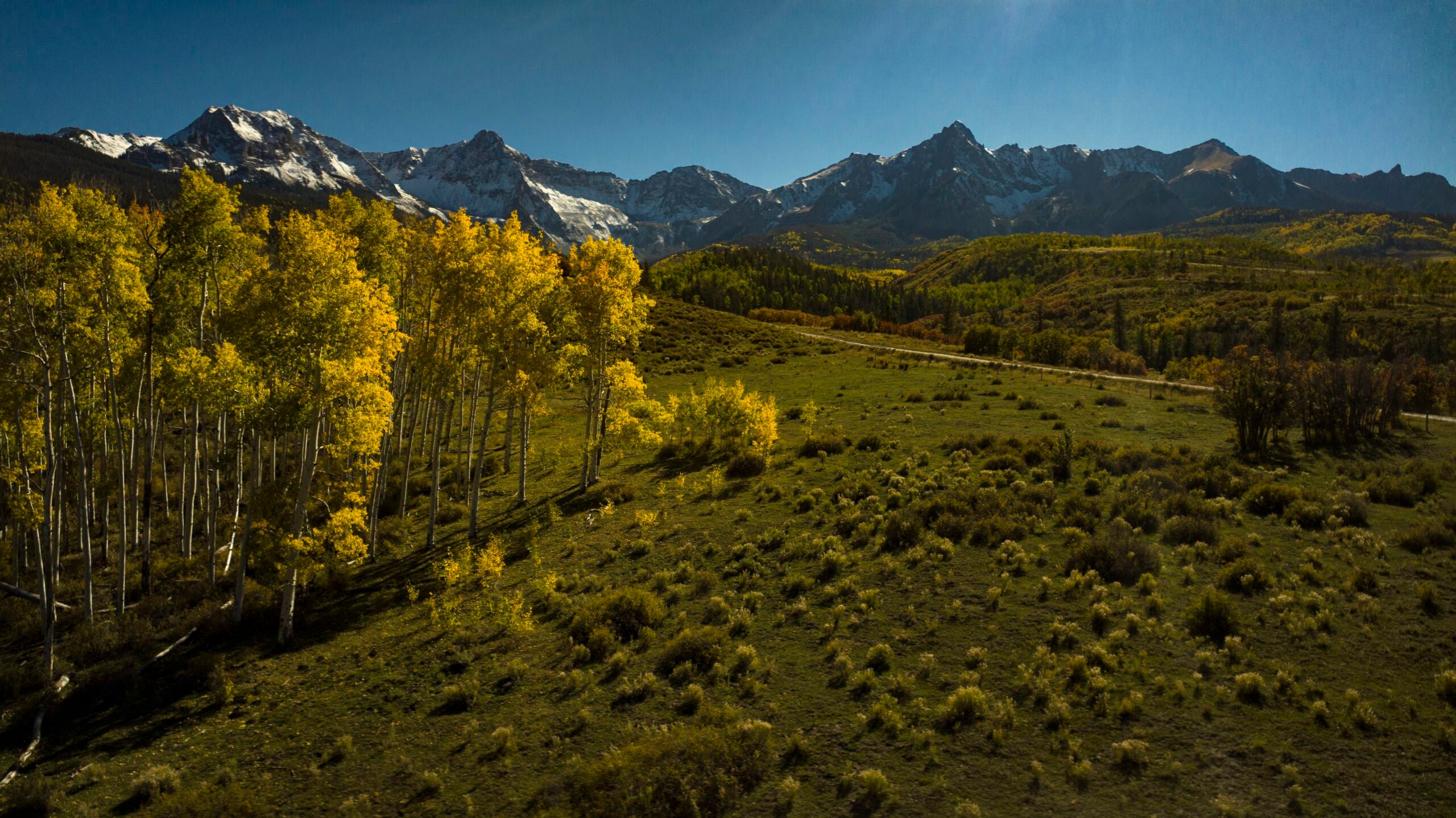
“Forty years is a very long time, but Carl’s bull is out there,” says famed former elk-hunting guide Ethan Kohn, who lives in Vail and has known Carl since the early ’90s, sometimes hunting with him. Kohn applies what he calls his “romanticized view” to Carl’s quest. “He’s gotta keep going on the journey. It’s a journey, man. Archery elk hunting is a good analogy for life. You can’t let it kick your ass. You gotta take those ass kickings and learn from them. If you keep putting in the time and effort, it’s gonna happen. And when it does, we’ll have a big celebration. We’ll eat the whole elk in one night.”
I had been wondering something about Carl, and after the herd split, it bubbled up again. Was hunting, as he insisted, merely about time spent outdoors, tuning in to nature and his mind, or did he actually care that he hadn’t gotten an animal? For every claim of the former, he also declared himself “the worst hunter” or harped on his bringing down the harvest rate for everyone. He still carried game bags in his blue backpack, which was adorned by a red and white patch from a fishing contest he’d won in 1971. So clearly conquest mattered and was worth planning for. But Carl had also lived below his means for much of his life; his definition of success differed from the mainstream’s. Like a lot of mountain men and women, he had sacrificed traditional metrics for more abstract ones.
As we trudged past hoof prints and dung piles, down to the season’s final hours, I could tell that Carl was waffling. “If I don’t get an elk, I’m OK with that,” he said. “To hear ’em all night, that was fucking amazing.” Then he pointed to where he’d seen the bull the prior evening, wistful. “His body was dragging on the ground, waiting to be eaten.” Carl bent to stretch his lower back under cotton-ball clouds. He had two artificial hips, and when his back got tight, his legs went numb and he hobbled, in obvious discomfort. “The doctors wanna operate,” he said. “I’m like, fuck that.” If he could still hunt, and ski and work and dance in the forest, his back was fine.
I told him he gave the season all he had.
“No,” he replied. “I think I can give more. I could live out in the woods the whole time. Rub shit on myself. Eat grubs. Don’t even bring the tent.” He sighed. “But in reality, I can barely walk.”
Suddenly, as if dropped by a spaceship, two bucks appeared, 50 yards out. They stared at Carl. He stared at them. They moved; we followed. Getting close enough to shoot, however, felt next to impossible, and eventually they bounded off through the trees.
We arrived back at camp to find Teig in surprisingly good spirits, processing the season. “Another tag sandwich, eh, Carl,” he ribbed his friend. We began to pack our gear. No more whispers. No more worrying about wind direction. Carl’s mood perked up. As much as he’d wanted to harvest an animal, it was not essential, now or ever. The silver lining sparkled: For one more hour, at least, he would be in the mountains, free to wander.
Carl imagines the day when he serves his friends elk for dinner, regaling them over juicy steaks that he harvested with an arrow—in a location he will keep to himself, of course.
“That’s what I can’t wait for,” he says, his eyes twinkling, “telling the story about the journey.”
This season’s futility is but another chapter before the happy ending.


